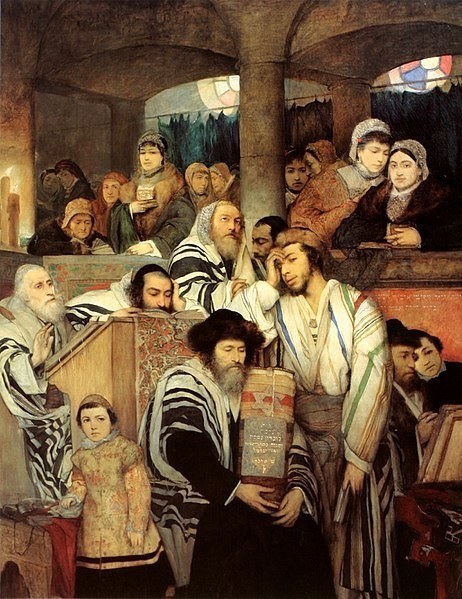
Hebrew culture has a long history of change. However, the diversity that exists in Hebrew culture today is not routinely considered. Hebrew people are often known to non-Hebrews by the culture of the dominant sects of Judaism that exist in their home regions. By examining Biblical Hebrew vs. modern Hebrew culture and religion, and observing recent manifestations, we might just be able to see Hebrews living among us in a new light.
Biblical Hebrews: Religious Identification
A productive way to analyze this change in culture over time would be to begin our investigation by gathering an understanding of how Hebrew people classified themselves during biblical times. Hebrew people of today often refer to themselves as Jews, and they study many books, including the Hebrew Bible, which recounts the origin of Judaism.
[Read here my article on how to study Biblical Hebrew online.]
In our study of the culture and religion of the Hebrews, the Hebrew Bible is a point of connection for both past and present Hebrews. Gathering an understanding of how the Hebrew Bible describes and distinguishes the Hebrew people will help us to understand which people considered themselves Hebrews and why. The Bible discusses the movements of the Hebrew people and how the religion was spread and solidified. From our understanding of Biblical Hebrews we will be more apt to understand modern-day Hebrew people.
So, who called themselves Hebrews? The first people whom the Bible designates as Hebrew people were offspring of Abraham, who was able to have many children. He was chosen to be the progenitor of the people of the Hebrew God due to his faith. Abraham was attributed the name ‘Ivri,’ which is comprehended as a phrase referring to a person who goes across something.
It is understood both figuratively and literally to apply to Abraham’s quest for Canaan (the land he would acquire according to God), and his transition from believing in many gods to believing in the Hebrew God. ‘Ivri’ used plurally refers to Abraham’s progeny, and after undergoing a phonetic transformation, it has become the word ‘Hebrew.’ Now, it is common to refer to something as ‘Hebrew’ as a way of saying that it is associated with these people.
Biblical Hebrews: Spreading the Religion
The shifting regional demarcations of various empires throughout the time of the Bible until the modern day, has had a significant effect on the culture of the Hebrew people. It has also affected who was classified as a Hebrew.
Before Jesus, there were people who were called Hebrews who served God and considered themselves the people of God. These people were called Israelites, who lived in a region that was then called Israel. However, they were taken as captives to Egypt and were eventually led out of Egypt on a long journey to a land promised to them by God. After a while of living on this land, the Israelites were corrupted by their prosperity and felt proud. They stopped serving their God and started to serve the gods of the nations that surrounded them.
Their God was angered, and after a while, they were invaded by people from different lands and taken captive many times. The Assyrians, Babylonians, and Egyptians invaded northern Israel and were thereby exposed to the religion of the Hebrews. Once the Hebrew religion was spread to non-Hebrews, new people began to call themselves Hebrew people, adopting the religion’s namesake.In antiquity the Hebrew Bible was translated into Greek, because many Hebrews could no longer understand the Biblical Hebrew of their sacred scriptures. This translation is known as the Septuagint.
[Read here my article on how to learn Biblical Greek online.]
Biblical Hebrew vs. Modern Hebrew Identity
Now that we have gathered some background knowledge of the Hebrews during the times of the Bible, it will be useful for us to gather some understanding of the Hebrew people that exist today. We can look at how they define the Hebrew identity, how the Hebrew identity manifests around the world, the uses and knowledge of the Hebrew language, and how these various groups of people use the Hebrew Bible.
[Read here my article on how to study Modern Hebrew online.]
Hebrews of today are commonly referred to as Jews. The term Hebrew is usually used to refer to a person who could be more easily be proven to be a descendant of the original Jews that existed in Biblical times. However, the practice of referring to oneself as a Hebrew person seems to have become obsolete. More often, people who were once considered Hebrews due to their religious association with the Jews of Biblical times will now refer to themselves as Jews.
Distinct sects of Jews began forming over the years of invasions and interactions with other nations. Each group of Jews practices their own type of Judaism, and their cultures differ from one another. They each employ the books of the Hebrew Bible, which is a collection of the words of the prophet Moses in the Torah, books containing other forms of writing such as proverbs and poetry, and the words of other prophets.
Modern Jews separate themselves from each other in many ways: Orthodox, Conservative, Reform, Humanistic, Reconstructionist, and Messianic. These ways differ by how much attention is paid to observing traditions, belief in God, and the spread of Judaism.
However, there are three major regional sects of Jews that this article will discuss: Ashkenazi, Sephardic, and Mizrahi. These are a few prominent contemporary types of Judaism. Other regional forms are also present today, like Ethiopian Judaism, but our regional discussion of Judaism will focus on these three common forms of Judaism.

Modern Hebrews: Ashkenazi Jews
The culture of the Jews of European descent is characterized by an extensive spread of their form of Judaism across multiple countries, and a large population around the world today. The language spoken by Jews of European descent is called Yiddish, and it is a mixture of German and Hebrew with some other languages incorporated as well.
Ashkenazi Judaism originated in Germany after locals received Judaism from trade encounters and spread Judaism across central and eastern Europe. In some cases, it overshadowed some of the already existent regional forms of Judaism in these countries. Much of the Yiddish language did not survive the attacks against Judaism from the Holocaust, since so many Ashkenazi Jews were killed.
Global attention to the culture of Ashkenazi Jews greatly increased during the world wars. Many Ashkenazi Jews were involved in the fighting in both World War I (WWI) and World War II (WWII). In the first World War, Jews in France, Britain, Russia, Germany, and Austria-Hungary fought for their respective countries’ forces. Some major consequences of WWI were the end of the reign of the Ottoman Empire, and the designation of British power over a newly created state in what was designated Palestine for the Jews.
An effort was made in the early 1900s to bring the Hebrew language back into practice as a spoken language. Knowledge acquisition of the Hebrew language was promoted enough for it to be considered the national language used by the Palestinian Jews.
In WWII, Jews in various countries fought in the war. They not only fought for the Allies, but some Jews also fought for Germany in the Axis powers. Finnish Jews joined Germany in fighting against the Soviet Union in order to show loyalty to Finland after a war between Finland and Russia ended with hostility.
Jewish Russian soldiers who were sent as youths to serve in Finland faced distrust from the Finnish people. However, they fought for Finland against Russia in what was known as the Winter War that ended close to the beginning of WWII. The results of all of this fighting on the part of the Jews were pretty significant. The immense suffering of the Jews in Germany and Poland during the Holocaust significantly decreased the population of Jews in those countries.
Modern Jews: Mizrahi Jews
Jews in areas of the Middle East are often misunderstood to be either Mizrahi or Sephardic. The language of Mizrahi Jews is characterized by a mix of Arabic and Hebrew. Since there are many forms of Arabic spoken within the Middle East, there are many kinds of Hebrew spoken by them today.
Much of their ancestry is linked to people in Yemen, Iran, and Iraq. Some of them also stem from North Africa and the Caucasus region. Israel is home to many Mizrahi Jews today, because many of them fled violence in their home countries and went to Israel. Many have also arrived in America.
Their population in Israel is large, but they do not have much political representation. Ashkenazi Jews have significant political power in Israel since the formation of the state after WWI. Ashkenazi Jews have tried to force the Mizrahi Jews in Israel to assimilate to their cultural standards. However, Mizrahi Jews strongly resisted these forces, and are focusing on assuring the visibility of their cultural heritage today.
Modern Jews: Sephardic Jews
Another type of Jew present in the Middle East are Sephardic Jews. They became prevalent after the spread of Sephardism during the reign of the Ottoman empire over the large portion of land that spanned from the Iberian peninsula to the Arabic-speaking countries of the Middle East. They originated in the Iberian peninsula, but they were expelled during the late 1400s when there was a push for conversion to Christianity.
This was enacted politically in 1492, under a mandate called the Alhambra Decree in Spain, and enforcement of Christianity in Portugal. At this time, the Ottoman empire was open to accepting the Spanish Jews as long as they paid a tax for each individual to the empire and admitted that Islam was the superior religion. They also moved to places in Amsterdam and North Africa.
Sephardic Jews are different in culture and language from their peers. The Ladino language was created from the spread of Judaism to the Iberian peninsula. It is a mixture of Hebrew language with the Latin language that was native to the Iberian peninsula at the time of the reception of Judaism.
Arabic, as well as Portuguese also are present in Ladino. Much like the Yiddish language of the Ashkenazi Jews, Ladino suffered from restrictions on Judaism from governmental concerns in Spain. The expulsion of the Sephardic Jews and their interactions with other nations and religions caused the formation of dialects of Ladino in various places.
It has undergone many alterations over time, and modern speakers use a different form of it that is rooted in Spanish and incorporates other languages such as Hebrew and Arabic.

Modern Jews: Messianic Jews and Christianity
Although a significant portion of this discussion has been about people who identify as Jews, Christians of today should also be considered in our discussion of modern Hebrews. Messianic Jews are people who practice the teachings of both the Old and New Testament of the Bible.
Whether Christians identify as Messianic Jews, or if they prefer to identify as Christian, Hebrew people exist in various forms today, including Christians. It is important to note that both followers of Christianity and followers of Judaism share a common belief in the Hebrew God. The Christian religion, however, often chooses to believe that the teachings of Jesus Christ (the son of the Hebrew God) in the New Testament should be observed.
The Quality of Being Hebrew
From our discussion of Biblical Jews, we discovered how they began to be referred to as Hebrews, and the significance of the term Hebrew and how they encountered some pressures that forced them to live outside of their homeland.
The movements of the Hebrew people contributed to the spread of the Hebrew religion to people who were not previously exposed to it. This prepared us for our discussion of the origins of popular contemporary forms of Hebrew religion. Our discussion of these forms of Hebrew religion showed us some of the struggles that Hebrew religion and culture has experienced and how these struggles affected the lives of modern-day Hebrews.
A significant take-away from this consideration of Hebrew culture and religion is that it has withstood many changes and challenges, yet it still lives as a dominant source of inspiration for common religions of today.